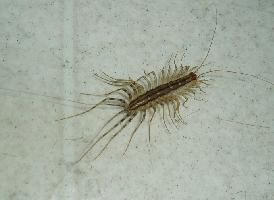
Description de l'animal
The house centipede, scientifically named Scutigera coleoptrata, is a species of centipede found in various parts of the world, particularly thriving in human dwellings. This arthropod is distinguished by its elongated, segmented body, which is typically yellowish to dark brown, adorned with three dark, longitudinal stripes. An adult house centipede can measure up to 25 to 38 millimeters in length, showcasing a slender and flexible form that aids in its swift movements.One of the most striking features of Scutigera coleoptrata is its 15 pairs of long, slender legs that radiate from its body like the spokes of a wheel, each pair increasing in length from the head to the rear. These legs are not only a marvel of natural engineering, providing exceptional speed and agility, but they are also equipped with delicate sensory hairs that help the centipede detect its surroundings and hunt its prey. The house centipede's speed is indeed remarkable; it is capable of running up and across walls and ceilings with astonishing agility, a trait that often startles human observers.
The house centipede's head bears two large, compound eyes, which are uncommon among centipedes, providing them with better vision than many of their relatives. Below its eyes, a pair of long, sensitive antennae extend forward, constantly probing the air for signs of prey or danger. Its mouthparts include sharp, venomous claws known as forcipules, which are a modified first pair of legs positioned directly beneath its head. These forcipules are used to inject venom into its prey, which consists mainly of other arthropods such as insects, spiders, and even other centipedes.
Scutigera coleoptrata is nocturnal, preferring to hunt under the cover of darkness. During the day, it seeks refuge in damp, secluded areas of homes such as bathrooms, basements, and behind furniture, emerging at night to feed. Despite its fearsome appearance and venomous bite, the house centipede is generally considered beneficial to humans, as it helps control pests by preying on insects that are often unwelcome in homes.
Reproduction in house centipedes involves a fascinating ritual where the male spins a small web and deposits a spermatophore for the female to pick up. After fertilization, the female lays her eggs in a damp, protected location. The offspring go through several molts before reaching adulthood, shedding their exoskeletons and gradually acquiring more legs with each stage.
While the house centipede's appearance may evoke fear or disgust in some people, it is a remarkable creature that plays a significant role in controlling pests. Its presence in a home is often a sign of a larger, underlying insect problem. Therefore, rather than being feared, the house centipede should be appreciated for its pest control capabilities, albeit from a respectful distance.
Nouvelles photos d'animaux
Top 10 des animaux
- Dolphin gull (Leucophaeus scoresbii)
- Japanese macaque (Macaca fuscata)
- Stone loach (Barbatula barbatula)
- Greek tortoise (Testudo graeca)
- Russian tortoise (Testudo horsfieldii)
- Galápagos tortoise (Geochelone nigra complex)
- Diana monkey (Cercopithecus diana)
- Moustached guenon (Cercopithecus cephus)
- Common flying dragon (Draco volans)
- Galápagos penguin (Spheniscus mendiculus)